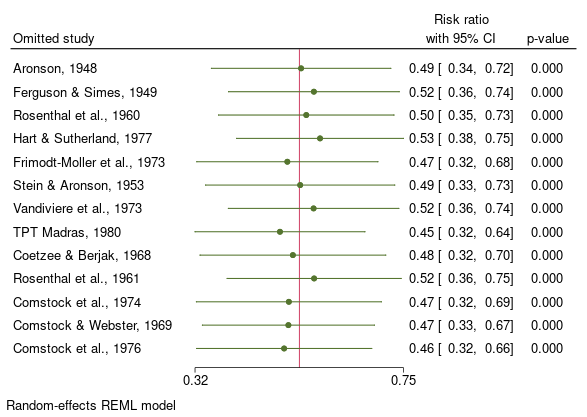New In 
Leave-one-out meta-analysis
Leave-one-out meta-analysis performs multiple meta-analyses by excluding one study at each analysis. It is common for studies to produce exaggerated effect sizes, which may distort the overall results. Leave-one-out meta-analysis is useful to investigate the influence of each study on the overall effect-size estimate and to identify influential studies.
You can now perform leave-one-out meta-analysis by using the new leaveoneout option with meta summarize and meta forestplot.
Let’s see it work
We will use the bcgset dataset of Colditz et al. (1994). This dataset has already been declared as metadata using meta esize. The BCG vaccine is used to prevent tuberculosis (TB). There are a total of 13 studies in the meta-analysis.
Highlights
- Functions that calculate durations, such as ages and other differences between datetimes
- Functions that calculate relative dates, or dates from other dates, such as the previous or next birthday or anniversary relative to a given date
- Functions that extract the different components from datetime values and variables
. webuse bcgset (Efficacy of BCG vaccine against tuberculosis; set with -meta esize-)
Suppose you performed a meta-analysis, and you suspect that some studies may be potential outliers. You can use leave-one-out meta-analysis to quantify the impact of these potential outliers on the estimation of the overall effect size
. meta forestplot, leaveoneout rr

For each study, the displayed effect size corresponds to an overall effect size computed from a meta-analysis excluding that study. The leave-one-out forest plot also displays a vertical line at the overall effect size based on the complete set of studies (with no omission) to help detect influential studies.
The omission of study 4 (Hart & Sutherland, 1977) or 8 (TPT Madras, 1980) seems to have a relatively larger influence (when compared with other studies) on the estimation of the overall effect size. Omitting study 4 causes the overall risk ratio to increase by roughly 0.04, whereas omitting study 8 causes the overall risk ratio to decrease by roughly 0.04.
References
Colditz, G.A., T.F. Brewer, C.S. Berkey, M.E. Wilson, E. Burdick, H.V. Fineberg, and F. Mosteller. 1994. Efficacy of BCG vaccine in the prevention of tuberculosis. Meta-analysis of the published literature. JAMA, 271: 698–702.
